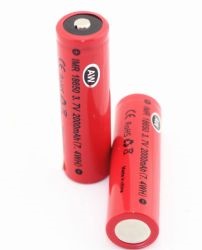
Switching from beginner-level electronic cigarettes and eGos to e-cig mods is a step up in terms of performance, but it brings some additional concerns with it.
The battery you use ceases to be provided with the device itself; you have to find one yourself. But lithium-based batteries, as we discussed earlier in the series, can all fail and in some cases it is catastrophic. There have been reports of bottle-rocket and pipe bomb-style explosions with mods, but the problem extends to all other lithium-dependent consumer products such as cell phones and laptops too.
Understanding the process of “thermal runaway” and what you can do to minimize the risk of e-cigarette mod explosions is essential for all vapers venturing into APV (Advanced Personal Vaporizer) territory.
Key Points
- Thermal runaway is a positive feedback loop, in which lithium battery temperature increases and results in “venting with flames” or explosion.
- It is very rare, and therefore unlikely to happen to you, but caution should still be exercised.
- Use safer chemistry (lithium-manganese, like AW IMR) batteries and get a high-quality charger (preferably with protection against overcharging). Cutting costs increases risks.
- The e-cig mod explosions to date have involved tube mods (mechanical or basic mods, not variable voltage/variable wattage mods) with two batteries stacked for higher voltage; so don’t stack multiple batteries.
- Ensure all metal tube mods have both electronic and physical safety features built in, such as vent holes and protective circuits.
- Follow earlier advice to reduce the chance of shorts – don’t carry your e-cig mod in a pocket with keys, coins, or anything metallic it could short out with.
- If anything goes wrong with your mod (rapid increase in heat, swelling or venting of hot gas) get it away from yourself as quickly as possible.

Safe chemistry batteries are always good to use no matter what. MOST e-cig mods being made these days with VV / VW have protection build into them that will prevent a catastrophic failure of the battery. Again… use that lock switch.
[If you notice your battery getting hot or swelling] get it out of the mod, and get it away from you. Either take the bottom or top connection off ASAP to break the circuit. Batteries venting or failing is a somewhat slow process. A warm battery or mod is the first sign that something is not right. – Nick “GrimmGreen” Green (GrimmGreen.com)

First, I don't know of any VV/VW device that doesn't have some type of protection already built in. So if you're using a regulated type device, chances are you're already protected. If you're using a mechanical mod, then yes, use a safer chemistry battery such as an IMR.
If you'd like to add another layer of protection, you can use a battery add-on fuse such as a 2-Cent or Vape Safe. – Phil Busardo (TasteYourJuice.com)

From a personal perspective, I will only ever use AW IMR batteries that use the safe chemistry. I have always felt comfortable using them but I'm very mindful that no battery is completely risk free from failure so if I notice anything strange going on that appears out of the ordinary then I will dispose of the battery and purchase a replacement.
In all honesty, I’m not 100% sure what the correct procedure is should you ever notice that a battery is overheating, but on the single rare occasion this has happened to me I immediately removed the battery and placed it outside out of harm’s way. I waited a few hours before returning to it and then disposed of it immediately
In this rare circumstance it’s vitally important to investigate what caused the issue before trying again with another battery. In my case, the rubber grommet that separates the positive and negative connections of the atomiser had failed which in turn created a short. – Scott Bonner (E-Cig-Reviews.com)

Use only batteries recommended by the manufacturer. In almost all cases these are going to be safer chemistry batteries such as IMR batteries. Most good quality variable power devices will have built-in safety circuits to shut down the device in the event of issues.
[Upon noticing your battery getting hot or swelling] if possible, remove the power from the battery (unplug the charger, or stop using the device). Unless absolutely necessary, do not touch the device for several minutes. Any batteries involved in a failure or suspected failure should immediately be disposed of according to proper disposal procedures (check with your city or county recycling information). Do not attempt to reuse a battery suspected of involvement with a failure, it's just not worth it to try and save a few bucks on new batteries. – Steve K (Steve K’s Vaping World)
What is Thermal Runaway?

Thermal runaway is an example of a positive feedback loop, which is basically a self-perpetuating cycle. With lithium-based batteries, this feedback comes in the form of heat, generating an increase in pressure which causes the battery to vent with flames (effectively a flamethrower) and – if the battery is tightly encased – potentially build up enough pressure to explode. This occurs because the battery generates more internal heat (because of the current flowing through it) than it can dissipate and this in itself leads to a further increase in heat. This can happen for numerous reasons.
One issue is a continuation of something we covered earlier in the series, short circuits. The low-resistance, high-current electronic shortcuts can be created by internal issues such as a convergence of microscopic metallic particles in one place (creating a path within the battery through which current can flow) or even a tear in the membrane separating the battery’s poles. External heat can also degrade the membrane, and other issues such as regular overcharging are also implicated in thermal runaway events.
Once the batteries reach a specific internal temperature, they become unstable and nothing can stop the failure from occurring. According to the Battery University, cobalt-cathode lithium batteries become unstable at 302°F (150 °C) and safer chemistry, manganese-cathode ones can reach 482 °F (250 °C) before becoming unstable.
The good news for vapers – and indeed, cell-phone, laptop and generally, any battery-operated electronics owners – is that these events are extremely rare. That’s why millions of people use lithium-based batteries every day safely; they’re a pretty safe type of battery. The problems are much more likely if they’re misused, though, so taking a few precautions can help ensure that you vape safely.
Which E-Cigs Are at Risk of Exploding?
A useful explanatory post on the ECF looks at the circumstances involved in reported e-cig explosions, and points out that only tube mods with two batteries stacked in series have been implicated.
This doesn’t include variable voltage/variable wattage (VV/VW) devices like the ProVari or eVic, for example, which have electronic circuits with safety features, only on “mechanical” tube e-cig mods without these features.
In addition, the use of venting holes (which should be present on any tube mod you have) gives the “first-stage” gas venting somewhere to go without building the pressure even further.
Reducing the Risk of E-Cig Mod Explosions

Firstly, you should pretty much buy the most expensive battery you can afford for your e-cigarette mod. This is not the place to skimp on cost, and a high-quality battery is hardly expensive. The red-colored AW IMR batteries use safer chemistry and have a good reputation, but be sure to buy them from a reputable source (counterfeiting is possible).
There is also a myth that smaller batteries are somehow safer, but if anything, the reverse is the case because larger batteries can generally deal with higher currents without becoming overworked.
For chargers, the same rule applies – get a high-quality charger (preferably one which shuts off automatically to prevent overcharging) and follow the safe charging advice from earlier in the series.
It should go without saying that stacking batteries is unnecessary and to be avoided.
Additionally, any e-cig mod – particularly a mechanical tube one – should have inbuilt safety features, such as vent holes (the larger the better) and an end cap (although this isn’t reliable if the battery swells and blocks the path to the bottom of the unit). Ideally, there will be some mechanism in place to relieve pressure in the upper portions of the mod, but this often isn’t present.
You should also follow the advice on preventing short circuits from earlier in the series, and don’t continue to use a low battery (on mechanical mods, nothing will warn you the battery is low, so check the voltage regularly), because the additional stress may give rise to a thermal runaway.
If your device can be turned off or locked (which effectively every mod can be), do so when you’re carrying it around. Some additional concerns when it comes to the current demand on batteries resulting from low-resistance atomizers will be covered in the next article in the series.
Again, this is very unlikely (especially if you follow the advice given so far), but thermal runaway and battery failure can still happen. If you sense anything going wrong (such as rapidly increasing heat on the body of the device, a swelling of the battery or a venting of hot gas), put the device in as safe a place as possible and move away from it. If it doesn’t feel too hot, you can remove the battery and put it somewhere it won’t do damage, but if you’re in doubt, it’s better to sacrifice a mod than be stuck in a room with a bottle-rocket/pipe bomb. It often happens immediately after charging, but you may not realize there’s a problem until some hot gas is vented. In this case, chances are you’ll instinctively drop it and protect yourself anyway, but the most important thing is to get it away from your face immediately.
Conclusion
Don’t panic! Aside from the straightforward precautions you should always take, this is a worst-case scenario concern. It isn’t the norm, and chances are you’ll never encounter a thermal runaway, especially on electronically controlled devices (vv/vw). However, pretending it couldn’t happen to you or cutting corners increases the chances, so it’s important to keep the risks in mind!
The Complete Guide to E-Cig Safety
Part One: Beginner E-Cigs Safety
1. Safe Use of Beginner E-Cigs
2. A Guide to Safe Charging
3. Carrying Your E-Cig Safely
4. Cartomizer Safety
5. Vaping and Driving
Part Two: E-Liquid Safety
6. Basic E-Liquid Safety
7. Allergies, Conditions and E-Liquid
8. Safe Nicotine Consumption for Vapers
9. Steeping E-Liquids Safely
10. Do E-Liquids Expire?
11. E-Liquid and Tank Safety
12. DIY E-Liquid Safety
Part Three: E-Cig Mod Safety
13. Minimizing the Risk of E-Cig Mod Explosions
14. E-Cig Mod Battery Safety and Ohm’s Law
15. Rebuildable Atomizer Safety
16. Mechanical Mod Safety
17. Wick Safety
18. Drip Tip Safety

